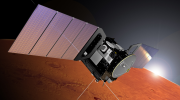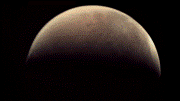Update from Spacecraft Operations Manager Michel Denis at ESOC:
Comet Siding Spring has flown by Mars .
Thanks to the DSN radio-science receiver at Madrid (then Goldstone) we could follow the Mars Express S-Band beacon practically all the time, including closest approach and comet plane crossing. Despite the very low level of concern, this was quite good to have.
After flyby, acquisition of signal occurred as planned at 22:25CEST, which implicitly confirmed that the spacecraft is operating normally. First systematic checks of spacecraft telemetry were performed for all sub-systems and showed fully nominal behaviour. There are no unexpected events or out-of-limits.
The downlink of the science data has started. The observation programme focused on the atmosphere/ionosphere continues for another two days. The HRSC pictures from the encounter are due for downlnk on Thursday.
After a year of intense preparation for technical readiness, our warm thanks to all teams who have supported the flight control team at ESOC, ESAC, ESTEC, NASA/DSN and beyond. We still have a mission.
Kind regards,
– MD




Discussion: one comment
So Mars has an ionosphere as well? Seeing Mars has far lower pressure at “sea” level, I expect the ionosphere also to start lower than earth’s as part of the ionisation-ability hinges on pressure? And Mars may then also have an ozone layer shielding some ultraviolet (although both ionizing radiation as well as UV rays may be far less “pungent” there as it further removed from the sun?